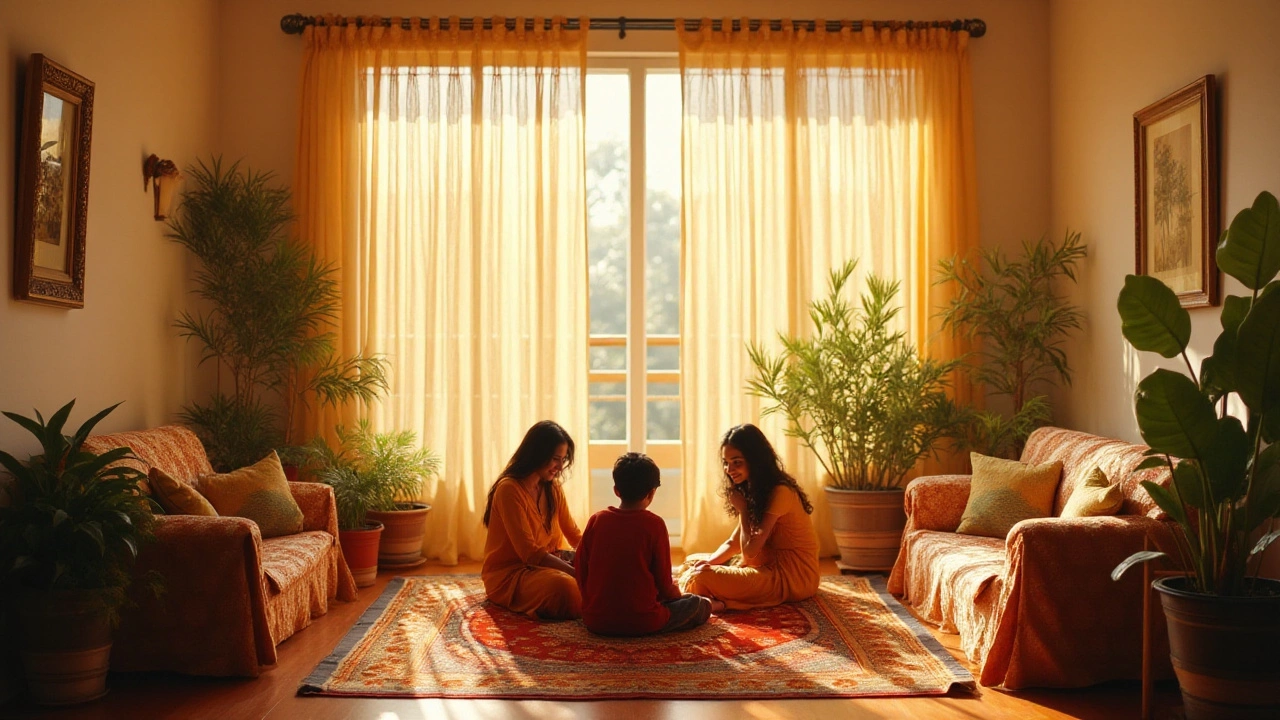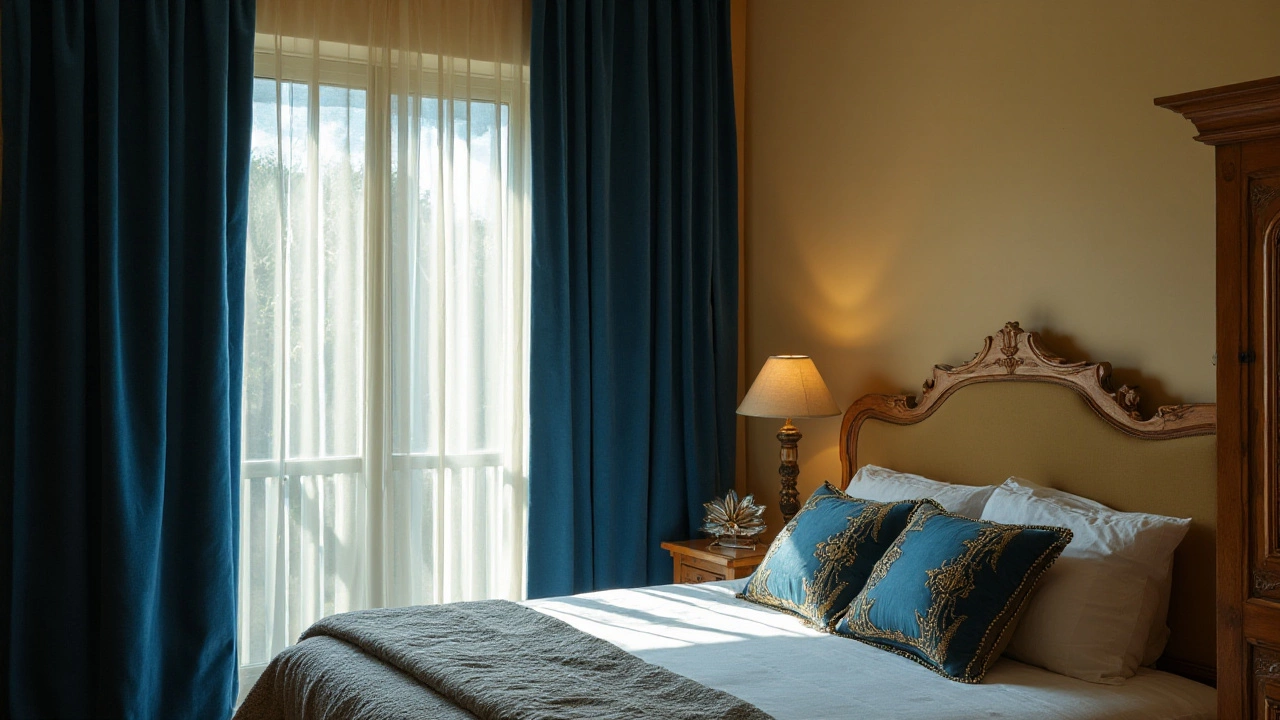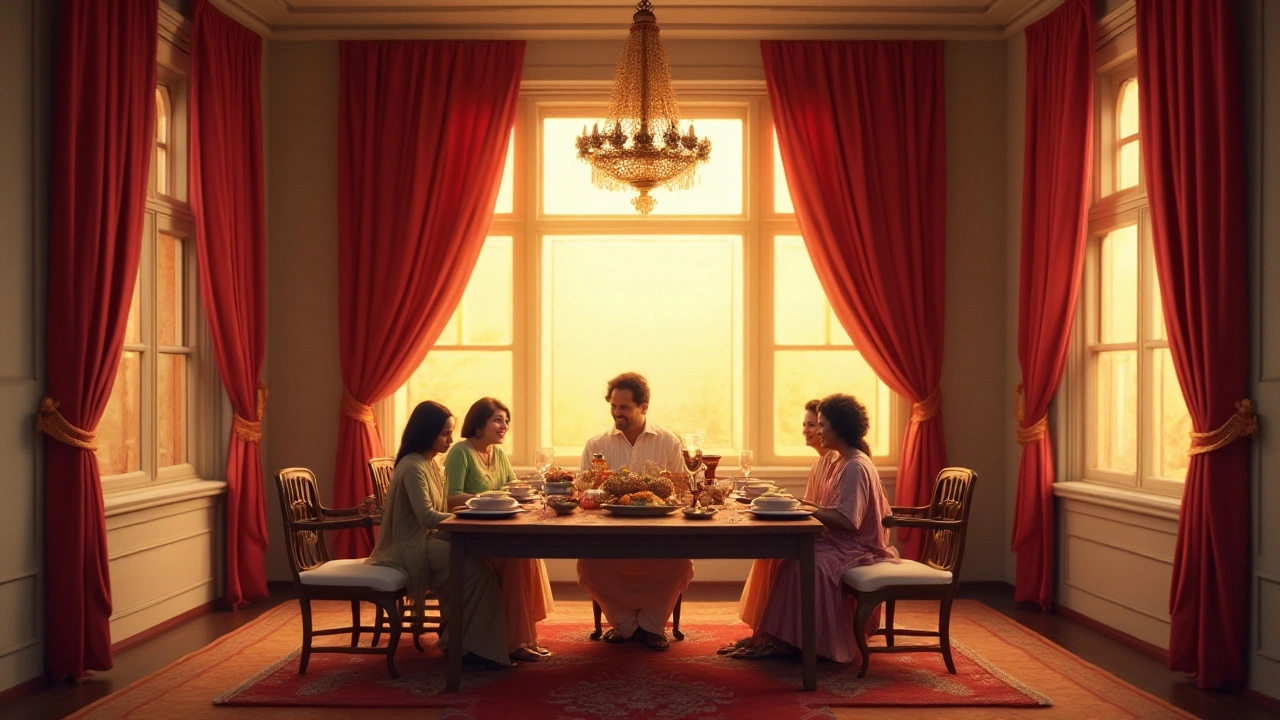Choosing the Perfect Curtain Color: Lighter or Darker than Walls?

When you're sprucing up your living space, one critical decision lies in selecting the right color for your curtains. It's a nuanced choice that might at first feel overwhelming. Curtains aren't merely functional items—they're an integral component of your room's aesthetic.
The color of your curtains can either harmonize with your wall shades or provide a striking contrast, each bringing its unique flair to your home. Depending on what you wish to achieve—be it a space that feels expansive and airy or one that's cozy and intimate—your choice between lighter or darker curtains matters.
Diving into the realms of room ambiance, lighting effects, and contemporary design trends, this guide aims to shed light on how you can curate the perfect curtain-to-wall color dynamics. Whether you're enhancing the comfort of your living room or injecting some personality into your bedroom, a thoughtful selection will go a long way in defining your home's distinct character. Explore practical tips and insights to make your space truly yours.
- Understanding Room Ambiance
- Impact on Room Size Perception
- Lighting Effects
- Trendy Combinations for Modern Homes
- Practical Tips for Choosing Curtain Colors
- Final Touches and Decor Harmony
Understanding Room Ambiance
In the world of interior design, room ambiance is a term that encapsulates the mood, feel, and character of a space. It’s that indescribable quality that makes a room feel open and welcoming or warm and snug. The ambiance is essentially the room’s personality, created by a harmonious blend of colors, textures, lighting, and decor elements. A critical factor that significantly influences room ambiance is the choice of curtain color versus wall color. This decision impacts more than just aesthetic appeal; it’s integral to how you experience the space.
Imagine entering a room where the surroundings feel balanced and inviting—it’s a play on textures and colors, and a primary driver of this vibe often lies in how curtain colors complement or contrast with the walls. For a calm and airy atmosphere, curtains lighter than the wall color can do wonders. This combination can make a room feel vast and open, especially if your space is small or doesn’t receive a lot of natural light. Light colors reflect more light, which can help to brighten up the room and create that serene sense of space.
On the other side of the color spectrum, opting for darker curtains than your walls instills a sense of coziness and intimacy. Darker hues absorb light, helping to create a warm and inviting landscape where the shadows settle just right, and everything appears in lovely contrast. This choice is ideal for large formal spaces or rooms meant for relaxation, such as a TV lounge or a bedroom. A famous designer once noted, “The right curtain can transform a room, tailoring it perfectly to suit your leisurely needs.”
Designer X says, "Curtains offer a final touch to adorn your walls like jewelry for the windows."
To truly capture the right mood within any given space, consider how each element interacts with light and color. Lighting and color work symbiotically—light reflects off differently hued curtains and walls, thus affecting the ambiance throughout the day. Selecting the perfect curtain color thus becomes a matter of aligning this relationship with your desired mood. For a modern, urban look, combining a soft gray wall with muted blue curtains creates a calm yet stylish environment. On the contrary, bold reds or rich greens against neutral walls can add drama and flair for a more flamboyant personality.
The pursuit of the right ambiance is about more than following trends; it’s a deeply personal journey that uncovers how a home can best mirror its inhabitants. With the freedom to experiment, mix and match, and complement or contrast, you craft a nuanced environment that aligns with your lifestyle and preferences. Ultimately, your choice of curtain color is more than a decorating decision; it plays an active role in shaping how inviting and livable your home feels. The correct balance can reinvigorate your living space, allowing each room to tell its own story through color and design.
Impact on Room Size Perception
Choosing the right curtain color is more than a detail in your interior design scheme; it transforms how the size of your room is perceived. When it comes to decorating small spaces, every choice contributes to creating an illusion of size. If you opt for curtains that are lighter than your walls, it can open up your space. Light curtains reflect natural light, making rooms feel brighter and, consequently, larger. This play with brightness tricks the eye into perceiving more space, breaking the boundaries that darker colors might impose upon the room.
Contrast this with darker curtains, which invoke a sense of depth and coziness. They tend to absorb light, cultivating an enveloping atmosphere. This can be beneficial in spacious rooms where the aim is to introduce warmth and intimacy. While this might sound counterintuitive to making a room appear larger, dark curtains juxtaposed with light walls can dramatically accentuate the verticality of the space. It's not just about making the walls recede but more about enhancing the elements that define and scale the room.
"Rooms that brim with natural light are perfect candidates for light curtain shades, as they complement and extend the airy feel," says interior designer Sophie Robinson, whose keen eye for mixing patterns and colors makes every space an artistic expression.
Attaining a balance is crucial; mismatched or ill-conceived combinations disrupt harmony. That's where certain nuances come into play. For instance, in minimalist décor, lean towards softer shades that cast seamless visual flow. This is especially true in contemporary homes where stark contrasts can feel less inviting and more jarring. It’s fascinating how strategic use of curtain colors can completely change not only dimensions but also the emotional receptivity of a space.
To guide your selection further, consider dual-purpose designs. These curtains, appearing distinctly lighter on one side and darker on the other, provide an opportunity to modulate the ambiance as needed. Layering lighter sheers with heavier, darker drapes grants homeowners flexibility and a chance to experiment with their space's perception dynamically throughout the day.
In practical terms, some choose to use specific curtain lengths and hang styles that subtly impact room perception, too. Floor-length drapes lend elegance and continuity, which elongates the wall and subsequently raises the perceivable height of the ceiling. These aesthetic tricks, rooted in visual manipulation, are a designer’s best friend when maximizing space without compromising on style.

Lighting Effects
When it comes to choosing curtains, few aspects are as crucial as understanding their impact on lighting effects in your space. Getting this right can completely change the way your home feels during different times of the day. The color and thickness of curtains influence how much natural and artificial light enters your room. Choosing lighter curtains might allow more sunlight to filter through, creating a soft, glowing environment that feels open and airy. This effect can be particularly beneficial in smaller rooms or during the winter months when daylight is limited. On the other hand, opting for darker curtains can serve to block out excess light, which can help maintain a cozy and intimate atmosphere, ideal for bedrooms or media rooms.
One interesting fact is that color theory plays a significant role in how light affects the perception of space. Lighter colors tend to reflect more light, which can elevate the mood of your home, offering a cheerful vibe. In contrast, darker colors absorb light, adding a rich depth to the room that many find comforting and conducive to relaxation. While considering these factors, it's also important to take into account the orientation of the room and its existing lighting sources. A room facing south, basking in plenty of natural light, could arguably afford to boast darker curtains without feeling gloomy, but the same choice in a north-facing room might overpower the little light that enters.
According to design expert Abigail Ahern, "Curtains are not just about keeping the light out, but controlling the ambiance of the room."Understanding this dual role can be critical in selecting the right curtain for each room. If privacy isn't a concern during daylight hours, semi-sheer curtains can strike a balance by diffusing harsh sunlight while still allowing views of the outside—a choice that integrates both function and style. Alternatively, employing a double curtain setup with lighter sheers and thicker darkening curtains can provide flexibility in adjusting the light dynamics throughout the day.
A practical tip to further customize lighting effects is to match or contrast curtain colors with paint that's been exposed to complementary temperature lighting. This involves a strategic mix of warm or cool lights with appropriate curtain hues, enhancing their effect. For instance, warm-hued curtains paired with incandescent bulbs can cast a cozy golden glow perfect for relaxation zones. On the flip side, cooler toned curtains with LED or fluorescent lights can maintain a crisp and clean look, often preferred for home offices or kitchens where clarity is key. Navigating these options with the right knowledge allows you to shape how a room feels every time you walk in, setting the mood effortlessly.
Trendy Combinations for Modern Homes
In the realm of modern home decor, where style meets functionality, the choice of curtain color is more than a simple aesthetic decision; it's a statement. Today’s designs embrace innovative combinations that not only enhance but redefine a living space. Consider pairing soft pastel curtains with neutral gray walls—this combination creates a serene atmosphere that is both refreshing and calming, perfect for spaces intended for relaxation, such as bedrooms or reading nooks. The subtlety of pastel against gray promotes an understated elegance that is timeless.
For those who love a bold aesthetic, opt for rich, deep-colored curtains like emerald green or navy blue against warm white or light beige walls. This contrast introduces a striking element of drama and sophistication, without overwhelming the senses. Such contrasts are perfect for main living areas or dining rooms where you want to leave a lasting impression. As one design expert noted "The elegance of deep hues creates a focal point that draws together a room's cohesive look."
"In selecting the right curtain color, one must balance style with practicality. Curtains should both define and elevate a space, offering privacy while enhancing natural light and ambiance." — Renowned Interior Designer, Sophie Carter
Complementing with Accents
For a touch of modern chic, incorporate accent colors that align with your curtain choices. This involves selecting throw pillows, rugs, or art pieces in shades that echo or complement your curtain colors. A clever use can be to choose a two-tone or patterned curtain where one of the tones complements your wall color, making the other tone your accent. Such thoughtful touches weave continuity into the decor, providing visual interest and cohesiveness.Some modern design influencers are experimenting with bold geometric patterns or nature-inspired motifs on curtains, paired with solid color walls. These patterns not only add a touch of creativity but also serve as personal expressions of taste, making a cherished statement piece within the home. Table 1 below demonstrates trending combinations that are capturing the hearts of homeowners worldwide.
| Wall Color | Curtain Color | Effect |
|---|---|---|
| Soft Gray | Pale Pink | Calming and Elegant |
| Warm White | Deep Navy | Striking and Focal |
| Light Beige | Forest Green | Inviting and Natural |
Remember, the key is to blend imagination with the science of design, ensuring that your home not only keeps up with trends but also reflects your unique personality. In the end, curtain choices are strongly personal, and within the tapestry of modern design, there remains ample room for authentic expression.

Practical Tips for Choosing Curtain Colors
Choosing the right curtain color is akin to crafting the perfect portrait of your space. Your decision can either melt seamlessly into the existing decor or inject new energy, almost like painting a bold accent wall. So, where to start? One practical step is to assess the current color palette of your room. Begin by identifying the dominant colors in furniture, walls, and accent pieces—this is your foundation.
Consider aiming for balance. For instance, if your room is filled with vibrant colorful accents, a more neutral curtain can provide a soothing balance. Alternatively, if the space feels somewhat muted, a contrasting bold curtain color might inject a much-needed zest. When you weigh lighter versus darker curtain colors, remember the rule of scale. Lighter curtains often make rooms feel larger, thanks to their ability to reflect light. On the contrary, darker curtains can create a sense of intimacy and depth, enveloping the room in a cozy cocoon.
Lighting plays a crucial role, too. Natural light influences how curtain colors are perceived; therefore, look at your potential choices in different lighting conditions—morning, afternoon, and nighttime. This helps ensure the color retains its intended effect at all times. A little trick from interior designers is to attach fabric swatches temporarily near your window. Observe how daylight, or the absence thereof, affects the hue.
Continuing with a practical approach, think about the function of the room. In rooms prone to high activity or sun exposure, durability is key. For areas such as kitchens or sunlit living rooms, lighter colors may impact how you perceive cleanliness or fading; thus, materials resistant to sunlight like linen or polyester blends can retain their vibrancy longer. Darker, heavier fabrics like velvet might be more suited for a theater-like environment in a home cinema room where light control is paramount.
One cannot ignore the power of personal preference. The emotion you wish to evoke can steer your curtain choice. According to a survey by color experts, around 60% of people associate blue with serenity and 70% associate red with excitement. Are you leaning towards curtains that energize your mornings, or those that ease you into relaxation? The curtains should serve your lifestyle goals.
“Curtains are more than drapes; they’re storytellers,” says Daniel Cortes, a renowned interior designer. Consider how your chosen color narrates the tale of the room.
Finally, don't shy away from seeking samples. Many home decor stores offer fabric samples, and this hands-on approach is invaluable. You can better envision the curtain within your room’s dynamic. Remember, the goal is to find a harmonious blend that complements your space, creating a balanced sanctuary that speaks to both aesthetic and practical needs.
Final Touches and Decor Harmony
As you reach the culmination of your interior design journey, the final touches are what turn a house into a home. These touches encompass the subtle interplay between your furnishings, accessories, and, significantly, your curtain color, which plays a critical role in blending your decor harmoniously. The decision on whether your chosen curtains are lighter or darker than the walls should aim to complement the existing elements in your room. When curtains align well with decor accents such as pillows, rugs, or artworks, they create a seamless flow that enhances the room's cohesion. Consider using textures and patterns to add depth to your space, which can make your palette pop even more.
To achieve decor harmony, follow a few guiding principles. Think of your room as a blank canvas; your furnishings and color choices are the paints that fill it. A balanced approach to color, where curtains either mimic hues from other decor elements or contrast with them in a deliberate way, can foster a sophisticated aesthetic. For example, pairing softer curtain tones with bold wall colors can introduce a calming effect, while darker curtains against lightly tinted walls can ground the decor and make a bold statement. This kind of thoughtful coordination can often be seen in professional design recommendations. A tip fervently echoed by many interior design experts is:
"Always let your personality shine through; decor should reflect who you are because you'll be the one living with it."
Additional aspects such as how your curtain choice interacts with natural light can also influence the room’s ambiance. Natural light highlights colors differently throughout the day, so it’s wise to observe your chosen hue during various times. For instance, heavier, darker drapes might add warmth during evening hours but could seem heavy during midday, especially in well-lit rooms. By understanding the balance of your home’s natural and artificial lighting, you can select curtains that adapt beautifully throughout the day. A well-selected curtain color can quietly bridge the gap between different decor styles and elevate the space altogether.
If you're considering blending styles, such as modern and rustic, curtains can serve as the perfect transitional piece to weave these themes together. A structured curtain color paired with traditional furniture can modernize a space, while vintage drapery styles can add character to minimalistic designs. Ultimately, it is these final stylistic decisions that tie the room together. Think of them as the cherry on top—a vivid finishing detail that elevates the entire decor scheme to new heights.
Aside from aesthetics, functionality should never be overlooked. Selecting heavy-duty fabrics for room-darkening purposes in bedrooms or lighter, airy materials for living spaces allows you to tailor your selections based on needs alongside taste. A curtain's ability to insulate can even impact your energy efficiency, making this choice as pragmatic as it is aesthetic. Ultimately, striking the right balance between beauty and utility results in a harmonious living environment that looks great and feels just right.